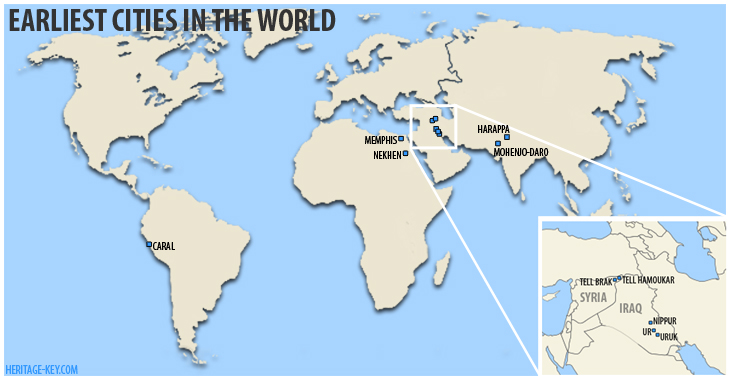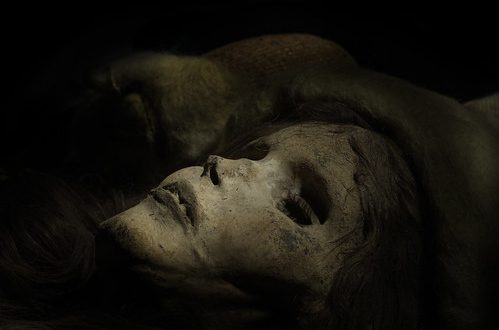 What makes a city? Certainly an abundance of people is needed (that and maybe a few skyscrapers too.) But when trying to find signs of urbanization in the ancient world, archaeologists like to look at more than just population size. Factors like whether or not a social hierarchy existed, was there a political system in place, and if the denizens specialized in different professions, are just some of the indicators used. Even the development of art and monuments can serve as benchmarks.
What makes a city? Certainly an abundance of people is needed (that and maybe a few skyscrapers too.) But when trying to find signs of urbanization in the ancient world, archaeologists like to look at more than just population size. Factors like whether or not a social hierarchy existed, was there a political system in place, and if the denizens specialized in different professions, are just some of the indicators used. Even the development of art and monuments can serve as benchmarks.
We’ve picked out 10 of the earliest cities in the world — each one being among the first to urbanize. But which of these is the oldest city in the world? The answer is not so straight-forward.
1: Uruk, the Official Earliest City
Archaeologists continue to dig up ancient settlements across the world, some of which existed far into the past. But whether or not they are simply villages, towns, or even cities is not always agreed upon.
One such settlement is located in Turkey. Called Çatalhöyük, the site was inhabited between 7500 BC and 5700 BC. More importantly, it had a relatively large population, from 5,000 people up to 10,000.
For a time Çatalhöyük might have laid claim to being humanity’s first city. The settlement’s intial excavators, who came during the 1960’s, believed the settlement to be a town or city that functioned as a trade and ritual centre. But more recent research has led archaeologists to believe otherwise, said Douglas Baird, a lecturer at the University of Liverpool.
“Most archaeologists now see it more as a large village,” Baird said. “My own survey work around the site suggests that the site could not have acted as a political or exchange centre for surrounding contemporary villages as there are none in the vicinity,” he added.
Other large settlements from 5500 BC and 2750 BC have also been found in Romania and Ukraine. But some experts have dubbed these sites, as well as Çatalhöyük, more as proto-cities that lacked distinctive features of urbanization.
At the same time, there are certain historical cities that, although just as ancient, didn’t experience urbanization until millennia later. Jericho is an example of this, having been settled by 9000 BC. Walls were subsequently built, but different views exist on whether the fortifications are evidence of urbanization.
Still, there is some consensus on which cities were the earliest. Charles Gates at Bilkent University in Turkey said, “The first certain cities — that all would agree on — would be the early Sumerian cities, with Uruk (prominent in the period 3,500 – 3,000 BC) standing at the head of the list.
Uruk, located in modern day Iraq, had already begun to exhibit the characteristic features of a city during the mid-4th century millennium BC. By this time Uruk had moved away from being a village, and functioned as a center of trade. Kings ruled over the city, while artisans produced monuments and works of art.
This urbanization is often thought to be brought about by the city’s prime location in Mesopotamia, leading to a surplus in food and then population boom. Experts believe that Uruk’s inhabitants had reached at least 50,000 people, and that by the 3000 BC, the city had likely become the largest in the world.
2: Ur – Sumerian capital
Urbanization was also sweeping across other Sumerian settlements. In southern Mesopotamia, where the Euphrates and Tigris rivers lie, many ancient villages such as Eridu and Lagash would also become cities. One of these larger settlements was Ur, which was founded as far back as 5,000 BC. Yet it was not until around 3,000 BC that Ur had turned from a village to a city that covered 37 acres in size.
The city grew in its importance when it became a capital for the Sumerian civilization in the early 3rd millennium BC. At this point, Ur’s population may have reached 65,000 residents. Archaeological excavations of the city have revealed temples, such as the Ziggurat of Ur, a massive religious monument built in the 21st century BC, which has more recently been home to US soldiers.
3: Nippur, City of Enlil
This holy Sumerian city was the seat of worship for the god Enlil. It was also first settled in 5,000 BC, but rose into a prominent city by the mid 3rd millennium BC due to its religious importance. By this time, the city likely had around 20,000 inhabitants.
Nippur contained not only religious temples, but also government buildings, as well as family businesses. One clay tablet found there is a library catalogue.
Because of its sacredness, the city was the site of royal pilgrimages, with kings seeking to gain legitimacy from the gods. Of all the Sumerian cities, Nippur was one of the longest lived, being inhabited until 800 AD.
4: Is Tell Hamoukar an Earlier First City?
Due to the advent of the Sumerian cities, Mesopotamia is often considered the cradle of civilization. But a more recent archaeological find made in Syria shows evidence that urbanization was also independently taking place farther north.
In 1999, a joint Syrian-American expedition found the remains of the settlement along the country’s border. Evidence shows that inhabitants lived on the site of Tell Hamoukar at least by 4000 BC, but that urbanization had already occurred by 3500 BC, near the same time as Uruk. Signs of this urbanization include food production on a mass-scale, the presence of administrative buildings, and an obsidian processing center.
Archaeologists have also found evidence that a battle took place at the city at 3500 BC. Sling bullets, collapsed walls and the remains of possibly war casualties have been found.
5: Tell Brak – More Urbanization in Northern Mesopotamia
Not far from Tell Hamoukar is another ancient settlement that has shown evidence of early urbanization. Excavations at Tell Brak, located in northern Syria, have revealed the formation of an early city that possessed its own industry. The finds include large ovens, and obsidian and flint tools, all dating back to the late 5th millennium BC to early 4th millennium BC. At the site, archaeologists have also found artwork such as an obsidian chalice, as well as clay seals crafted with symbols on them, and ‘eye idols‘.
Two large burial sites discovered at the site also seem to indicate the presence of warfare. The burial sites, dated to the early to mid 4th millennium BC, could suggest that the settlement was facing societal pressures such as economic inequality or political struggle.
6: The Early Egyptian Capital of Nekhen
The Nile River has acted as its own birthplace for urbanization. One of these oldest settlements was Nekhen, an Egyptian city that dates back to around 3500 BC.
The city was formed before the Egyptian dynasties had been established. Instead, it functioned as a capital for Upper Egypt until around 3100 BC. During this period the city could have had a population from 5,000 to 10,000 people.
Nekhen was also a center for religious power, with the Egyptian god Horus, acting as the city’s patron deity. Later the city would also come to be known as Hierakonpolis, or “City of the Hawk” by the Greeks.
7: Memphis – Further Urbanization at the Nile River
Founded in 3100 BC, Memphis would become the new capital of Ancient Egypt after Nekhen. The city came to be after an Egyptian king had united both Upper and Lower Egypt into a single kingdom. Like Nekhen, Memphis is also located at the Nile River, just south of where it separates into different branches.
The city’s population, from it’s founding to 2250 BC, could have ranged from 6,000 residents to 30,000. Throughout the history of Ancient Egypt, the city remained a political center, even as other Egyptian cities rose to prominence.
Memphis was also home to the temple of Ptah, another Egyptian god.
8: Mohenjo-daro of the Indus Valley
Based in what is present day Pakistan, Mohenjo-daro was founded at around 2600 BC. The ancient settlement was located at the Indus River, which also served as a lifeline to other rising cities in the region by the mid 3rd millennium BC.
Mohenjo-daro likely had a population of 35,000 at its height, and was about one square mile in size. The city was well planned, built with perhaps one of the earliest urban sanitation systems. Buildings included houses, granaries, baths, as well as assembly halls, and towers used as fortifications. But at around 1900 BC, the city had been abandoned, possibly due to war or climate change in the region.
9: Harappa – Center for Trade and Power
Also emerging at the Indus River was the city of Harappa. Like Mohenjo-daro, the settlement was founded at around 2600 BC, and also features extensive urban planning for its time.
Evidence suggests that both Mohenjo-daro and Harappa functioned as major capitals for what is known as the Harappan culture. The cities also served as centers for trade, with mercantile links extending out toward Persia, Afghanistan and Mesopotamia. An early writing system was also in use, as evidenced by the different symbols found on excavated pottery.
Population at the city likely reached to more than 20,000 residents. But by 1900 BC, the city had also been abandoned.
10: Caral – Urbanisation Hits the New World
Often regarded as the first urban center in the Americas is Caral, an archaeological site located in Peru. Though the site had already been discovered decades before, it was not until 2001, when radiocarbon dating showed that the settlement had been inhabited from 2600 to 2000 BC. The find made headlines, providing evidence that early forms of urbanization were not solely isolated to Mesopotamia and Egypt.
Large in size, Caral extended across 160 acres, and included pyramids, temples, amphitheaters and houses. The population at Caral has been estimated to be only 3,000 people. But it may have simply served as a center to other neighboring settlements in the area, which would have made the population reach as high as 20,000 residents.






